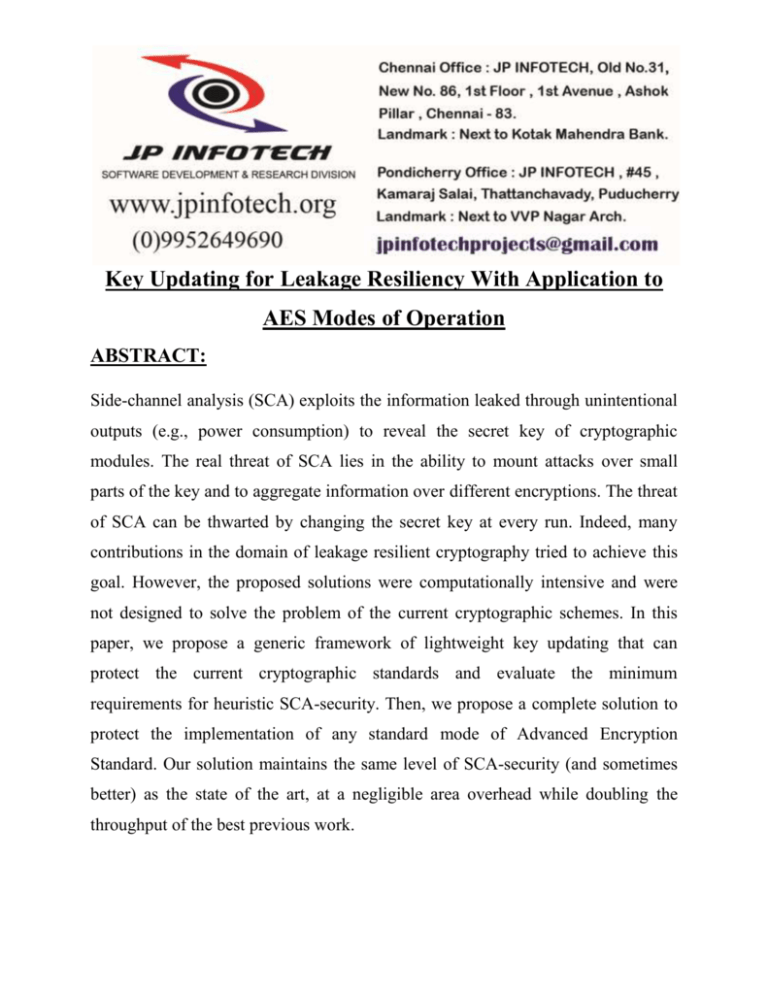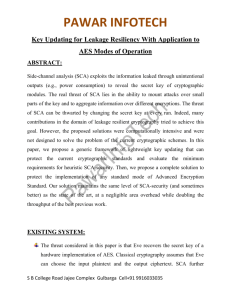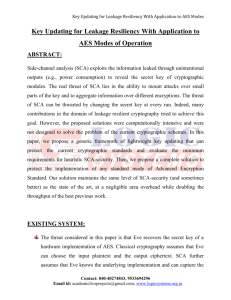Key Updating for Leakage Resiliency With Application to AES
advertisement

Key Updating for Leakage Resiliency With Application to AES Modes of Operation ABSTRACT: Side-channel analysis (SCA) exploits the information leaked through unintentional outputs (e.g., power consumption) to reveal the secret key of cryptographic modules. The real threat of SCA lies in the ability to mount attacks over small parts of the key and to aggregate information over different encryptions. The threat of SCA can be thwarted by changing the secret key at every run. Indeed, many contributions in the domain of leakage resilient cryptography tried to achieve this goal. However, the proposed solutions were computationally intensive and were not designed to solve the problem of the current cryptographic schemes. In this paper, we propose a generic framework of lightweight key updating that can protect the current cryptographic standards and evaluate the minimum requirements for heuristic SCA-security. Then, we propose a complete solution to protect the implementation of any standard mode of Advanced Encryption Standard. Our solution maintains the same level of SCA-security (and sometimes better) as the state of the art, at a negligible area overhead while doubling the throughput of the best previous work. EXISTING SYSTEM: The threat considered in this paper is that Eve recovers the secret key of a hardware implementation of AES. Classical cryptography assumes that Eve can choose the input plaintext and the output ciphertext. SCA further assumes that Eve knows the underlying implementation and can capture the instantaneous power consumption. In the domain of leakage resiliency, it is also assumed that Eve can run any polynomial-time function (called leakage function) on the power consumption to recover some bits of the secret key. The two categories of key-updating are stateless and stateful. One mechanism or the other is sufficient for a limited set of applications. However, the two mechanisms are both required for a complete and generic solution. Stateless key-updating assumes that the two communicating parties share only the secret key and a public variable (nonce) i.e. there is no shared secret state between them. This updating mechanism is required whenever there is no synchronization between the two communicating parties e.g. during initialization of a secret channel. Stateless key-updating provides a complete solution for applications with single cryptographic execution e.g. challenge response protocols. Stateful key-updating assumes that the two communicating parties share a common secret state (other than the key). They both can update the secret key into a new key without requiring any external variables. This scheme can provide a complete solution for synchronized applications e.g. key-fobs. DISADVANTAGES OF EXISTING SYSTEM: There is no provably secure construction that supports stateless keyupdating. Intuitively speaking, the secret key cannot be updated to a new key unless a public variable is used (assuming no synchronization). Once a public variable interacts with a secret key, SCA will be possible. Some contributions tried to secure the stateless key-updating mechanism through hiding and masking. Although this approach limits the implementation overhead exclusively to the key-updating mechanism, allowing the use of unprotected cryptographic cores, the overall overhead is still significant PROPOSED SYSTEM: The proposed solution at the system level works as follows. We assume that an application on Device A needs to send secure data to an application on Device B. Both devices share a secret key, which we name master key. They can initiate the channel by exchanging a public nonce, and send the secure data using any cryptographic primitive (AES) running in a mode of operation. Although the black-box security of these modes is guaranteed by the cryptographic primitive, security is not guaranteed if Eve can monitor Device A. Here, we target protecting the master key against any SCA attack. Device A starts with a stateless key-updating mechanism to compute a pseudorandom secret state out of the master key and the nonce. Then, the stateful keyupdating is executed, to compute running keys. Finally, the actual cryptographic mode is called using the input data and the same previously used nonce. Our solution honors the tree structure for the stateless key-updating. Each step of the tree involves processing a single bit of the nonce through a lightweight whitening function (Wt: whitening in the tree). The tree starts from the master key, and ends with a pseudorandom secret state. For the stateful key-updating, we use a chain of whitening functions (Wc: whitening in the chain). Every execution of the whitening function generates a new running key. ADVANTAGES OF PROPOSED SYSTEM: We focus on achieving a sound security at the smallest implementation cost (area and performance). To achieve this goal, we propose a generic framework for lightweight key-updating and evaluate the minimum requirements for SCA-security. Then, we propose a solution that maintains the same level of SCA-security (and sometimes better) as the state of the art, at a negligible area overhead while doubling the throughput of the best previous work. SYSTEM ARCHITECTURE: SYSTEM REQUIREMENTS: HARDWARE REQUIREMENTS: System : Pentium IV 2.4 GHz. Hard Disk : 40 GB. Floppy Drive : 1.44 Mb. Monitor : 15 VGA Colour. Mouse : Logitech. Ram : 512 Mb. SOFTWARE REQUIREMENTS: Operating system : Windows XP/7. Coding Language : JAVA IDE : Netbeans 7.4 Database : MYSQL REFERENCE: Mostafa Taha, Member, IEEE, and Patrick Schaumont, Senior Member, IEEE, “Key Updating for Leakage Resiliency With Application to AES Modes of Operation”, IEEE TRANSACTIONS ON INFORMATION FORENSICS AND SECURITY, VOL. 10, NO. 3, MARCH 2015.










